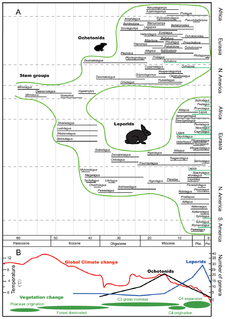أرنبيات الشكل
| أرنبيات الشكل Lagomorphs[1] | |
|---|---|
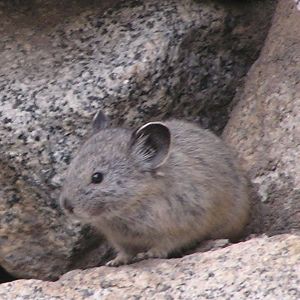
| |
| Pika, Ochotona princeps, in Sequoia National Park | |
| التصنيف العلمي | |
| مملكة: | |
| Phylum: | |
| Class: | |
| Infraclass: | |
| Superorder: | |
| Order: | الأرنبيات برانت، 1855
|
| عائلات | |
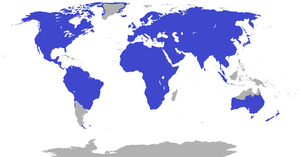
| |
| Range of Lagomorpha | |
أرنبيات الشكل Lagomorpha هي إحدى رتب الثدييات، وتنقسم إلى عائلين، الأرانب والبيكاوات، ويتفرعان إلى 13 جنس و80 (أحياء)|نوع.
. . . . . . . . . . . . . . . . . . . . . . . . . . . . . . . . . . . . . . . . . . . . . . . . . . . . . . . . . . . . . . . . . . . . . . . . . . . . . . . . . . . . . . . . . . . . . . . . . . . . . . . . . . . . . . . . . . . . . . . . . . . . . . . . . . . . . . . . . . . . . . . . . . . . . . . . . . . . . . . . . . . . . . . .
الانتشار
تنتشر الأرنبيات في كل قارات العالم ما عدا أستراليا وأنتركتيكا، وغير موجودة في جنوب الأمريكية.
الخصائص
تتميز حيوانات رتبة أرنبيات الشكل بأنها متوسطة الحجم، تشبه القوارض في كثيرٍ من تصرفاتها وسلوكها، وهم يملكون أذيلااً قصيرة، وقد أدخلها البشر إلى الكثير من مناطق العالم التي لم تكن تعيش فيها سابقاً.
تجتمع طيات الجلد على الشفتين وراء القواطع بحيث بحيث يمكنها الأكل مع إبقاء تجويف الفم مغلقاً، وهي تملك زوجاً من القواطع في كل مربعٍ من الفك العلوي، وهي تملك قواطع كبيرةٍ مثل التي تملكها القوارض، وهذه القواطع الكبيرة تستمر في النمو مدى الحياة، لذلك على الأرنبيات أن تقوم بعض الأشياء وتقصير القواطع الكبيرة باستمرار وإلا طالت وانغرست في رقبتها وقتلتها.
وجميع الأرنبيات تعيش تحت الأرض وهي تعيش في كل مكانٍ بدءاً من الغابات الاستوائية وحتى التندرا القطبية، وتقوم الأرنبيات بإخراج نوعين من الفضلات، أحدهما هو الرطب وتأكله مرة أخرى لمزيد من امتصاص المغذيات، والنوع الآخر هو النوع الجاف وهي تتركه.
Differences between lagomorphs and other mammals
Although lagomorphs are more closely related to rodents than any other mammals,[2] the two orders still have some major differences. Lagomorphs differ from rodents in that the former have four incisors in the upper jaw (not two, as in the Rodentia). Also, lagomorphs are almost strictly herbivorous, unlike rodents, many of which will eat both meat and vegetable matter. They resemble rodents, however, in that their incisor teeth grow continuously throughout their lives, thus necessitating constant chewing on fibrous food to prevent the teeth from growing too long.[3][4]
Differences between families of lagomorphs
Pikas
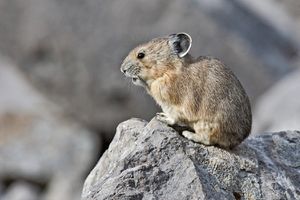
Hares
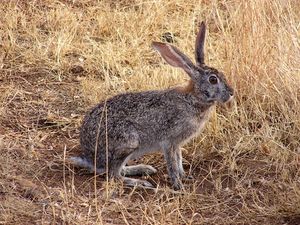
Hares, members of genus Lepus of family Leporidae, are medium size mammals native to all the continents except South America, Australia and Antarctica. North American jackrabbits are actually hares. Species vary in size from 40 to 70 cm (16 to 28 in) in length and have long powerful back legs, and ears up to 20 cm (8 in) in length. Although usually greyish-brown, some species turn white in winter. They are solitary animals and several litters of young are born during the year in a form, a hollow in the ground amongst dense vegetation. The young are born fully furred and active. Hares eat plant material including stripping the bark off tree trunks. They are preyed upon by large mammalian carnivores and birds of prey.[5]
Rabbits
Rabbits, members of family Leporidae outside Lepus, are generally much smaller than hares and include the rock hares and the hispid hare. They are native to Europe, parts of Africa, Central and Southern Asia, North America and much of South America. They inhabit both grassland and arid regions. They vary in size from 20 to 50 cm (8 to 20 in) and have long, powerful hind legs, shorter forelegs and a tiny tail. The colour is some shade of brown, buff or grey and there is one black species and two striped ones. Domesticated rabbits come in a wider variety of colours. Although most species live and breed in burrows, the cottontails and hispid hares have forms (nests). Some of the burrowing species are colonial, but most are solitary or may feed together in small groups. Rabbits play an important part in the terrestrial food chain, eating a wide range of forbs, grasses, and herbs, and being part of the staple diet of many carnivorous species.
Distribution
Lagomorphs are widespread around the world and inhabit every continent except Antarctica. However, they are not found in most of the southern cone of South America, in the West Indies, Indonesia or Madagascar, nor on many islands. Although they are not native to Australia, humans have introduced them there and they have successfully colonized many parts of the country and caused disruption to native species.[6]
التصنيف
- Order Lagomorpha Brandt 1885[1][8]
- Family Leporidae Fischer de Waldheim 1817 (rabbits and hares)
- Subfamily † Archaeolaginae
- Genus †Archaeolagus Dice 1917
- Genus †Hypolagus Dice 1917
- Genus †Notolagus Wilson 1938
- Genus †Panolax Cope 1874
- Subfamily Leporinae Trouessart 1880
- Genus †Alilepus Dice 1931
- Genus Brachylagus
- Genus Bunolagus
- Genus Caprolagus Blyth 1845
- Genus Lepus Linnaeus 1758
- Genus Nesolagus Forsyth Major 1899
- Genus Oryctolagus Lilljeborg 1874
- Genus †Nuralagus Lilljeborg 1874
- Genus Pentalagus Lyon 1904
- Genus †Pliolagus Kormos 1934
- Genus †Pliosiwalagus Patnaik 2001
- Genus Poelagus
- Genus †Pratilepus Hibbard 1939
- Genus Pronolagus Lyon 1904
- Genus Romerolagus Merriam 1896
- Genus †Serengetilagus Dietrich 1941
- Genus Sylvilagus Gray 1867
- Subfamily †Palaeolaginae Dice 1929
- Tribe †Dasyporcina Gray 1825
- Genus †Coelogenys Illiger 1811
- Genus †Agispelagus Argyropulo 1939
- Genus †Aluralagus Downey 1968
- Genus †Austrolagomys Stromer 1926
- Genus †Aztlanolagus Russell & Harris 1986
- Genus †Chadrolagus Gawne 1978
- Genus †Gobiolagus Burke 1941
- Genus †Lagotherium Pictet 1853
- Genus †Lepoides White 1988
- Genus †Nekrolagus Hibbard 1939
- Genus †Ordolagus de Muizon 1977
- Genus †Paranotolagus Miller & Carranza-Castaneda 1982
- Genus †Pewelagus White 1984
- Genus †Pliopentalagus Gureev & Konkova 1964
- Genus †Pronotolagus White 1991
- Genus †Tachylagus Storer 1992
- Genus †Trischizolagus Radulesco & Samson 1967
- Genus †Veterilepus Radulesco & Samson 1967
- Tribe incertae sedis
- Genus †Litolagus Dawson 1958
- Genus †Megalagus Walker 1931
- Genus †Mytonolagus Burke 1934
- Genus †Palaeolagus Leidy 1856
- Tribe †Dasyporcina Gray 1825
- Subfamily † Archaeolaginae
- Family Ochotonidae Thomas 1897 (pikas)
- Genus †Alloptox Dawson 1961
- Genus †Amphilagus Tobien 1974
- Genus †Bellatona Dawson 1961
- Genus †Cuyamalagus Hutchison & Lindsay 1974
- Genus †Desmatolagus Matthew & Granger 1923
- Genus †Gripholagomys Green 1972
- Genus †Hesperolagomys Clark et al. 1964
- Genus †Kenyalagomys MacInnes 1953
- Genus †Lagopsis Schlosser 1894
- Genus Ochotona Link 1795
- Genus †Ochotonoides Teilhard de Jardin & Young 1931
- Genus †Ochotonoma Sen 1998
- Genus †Oklahomalagus Dalquest et al. 1996
- Genus †Oreolagus Dice 1917
- Genus †Piezodus Viret 1929
- Genus †Russellagus Storer 1970
- Genus †Sinolagomys Bohlin 1937
- Genus †Titanomys von Meyer 1843
- Family †Prolagidae Gureev, 1962 (Sardinian pika and other related extinct pika-like lagomorphs)
- Genus †Prolagus Pomel 1853
- Family incertae sedis
- Genus †Eurolagus Lopez Martinez 1977
- Genus †Hsiuannania Xu 1976
- Genus †Hypsimylus Zhai 1977
- Genus †Lushilagus Li 1965
- Genus †Shamolagus Burke 1941
- Family Leporidae Fischer de Waldheim 1817 (rabbits and hares)
. . . . . . . . . . . . . . . . . . . . . . . . . . . . . . . . . . . . . . . . . . . . . . . . . . . . . . . . . . . . . . . . . . . . . . . . . . . . . . . . . . . . . . . . . . . . . . . . . . . . . . . . . . . . . . . . . . . . . . . . . . . . . . . . . . . . . . . . . . . . . . . . . . . . . . . . . . . . . . . . . . . . . . . .
انظر أيضا
المصادر
- ^ أ ب قالب:MSW3 Hoffmann
- ^ "Natural History Collections: Introduction to Lagomorphs". www.nhc.ed.ac.uk. Retrieved 2015-08-18.
- ^ Best, T. L., Henry, T. H. (1994-06-02). "Lepus arcticus". Mammalian Species. 457 (457): 1–9. doi:10.2307/3504088. ISSN 0076-3519. JSTOR 3504088. OCLC 46381503.
{{cite journal}}: CS1 maint: multiple names: authors list (link) - ^ خطأ استشهاد: وسم
<ref>غير صحيح؛ لا نص تم توفيره للمراجع المسماةBritannialagomorph - ^ Smith, Andrew T. "Hare". Encyclopædia Britannica. Retrieved 2013-08-15.
- ^ Klappenbach, Laura. "Hares, Rabbits and Pikas". About.com. Retrieved 2013-08-14.
- ^ Ge, Deyan; Wen, Zhixin; Xia, Lin; Zhang, Zhaoqun; Erbajeva, Margarita; Huang, Chengming; Yang, Qisen (April 3, 2013). "Evolutionary History of Lagomorphs in Response to Global Environmental Change". PLoS ONE. 8 (4:e59668): e59668. doi:10.1371/journal.pone.0059668. PMC 3616043. PMID 23573205. Retrieved May 22, 2014.
{{cite journal}}: CS1 maint: unflagged free DOI (link) - ^ The Paleobiology Database Lagomorpha entry Accessed on 13 May 2010

